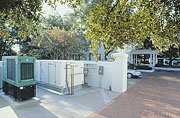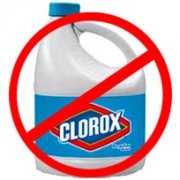Austin’s Honorable HVAC
Indoor air quality hasn’t made it into presidential campaign discourse so far in the proceedings, but at least one candidate has recent firsthand experience on the subject. Some of the remediation industry’s best consulting engineers, mechanical contractors, and equipment worked to reverse IAQ problems in Austin’s 143-year-old Governor’s Mansion. As a result, Gov. George W. Bush and his wife are now staunch air quality advocates.
“We all notice a significant difference in the quality of the air now that the retrofit has been completed,” reports Governor’s Mansion administrator Anne DeBois, who has served under four governors. Previously, the 9,000-sq-ft, 27-room historic mansion suffered high levels of mold and mildew counts during Texas’ seasonably hot and humid summer months. The levels not only posed health concerns for inhabitants, state workers, and thousands of annual tourists, but they also created the expected unappealing odors. Volz & Associates, Inc. (Austin, TX) spearheaded the renovation, which also included roof replacement and security updates. The firm put together an HCAC team that had to:
- Ascertain how to increase outside air;
- Negotiate significant space limitations while getting that air into the distribution system;
- Update existing equipment; and
- Determine that all work meets historical building guidelines outlined by the Texas Historical Commission and the architect.
Constant Source of Discomfort

A 75-ft PVC duct connects this Dectron (Montreal) dehumidifier to the Mansion. The unique challenges in running this duct would convince engineers to use an indoor humidifier later in the project. Photo by J.T. Guerrero.
The IAQ problems were solved by consultants William Holder, senior vice president of Assured Indoor Air Quality (Dallas); and Bill Harris, P.E., president of HMG & Associates (Austin). TDIndustries (Dallas), the largest employee-owned mechanical contractor in the nation, was the project’s mechanical contractor. While both consultants conceived the solutions, Harris’ firm performed the design work. Meanwhile, Holder developed the design criteria and served as commissioning authority. “This was perhaps one of the most challenging and complicated design jobs that I’ve had in my 26 years in the HVAC business,” said Harris, whose firm has provided mechanical and electrical consulting for projects ranging from large 15,000-sq-ft residences to 300,000-sq-ft, $50 million commercial buildings.
The existing HVAC system consisted of a 20-yr-old double-duct, variable air volume (VAV) design with 15 zones. Equipment consisted of two 30-ton chillers (one as a backup), a 300,000-Btu boiler, and one built-up AHU. Although less than 10% of the system’s total 10,000 cfm consisted of untreated outside air, that ‘small’ introduction of air during air conditioning season helped produce mold and mildew growth that propagated throughout the year. For the new system, the designers opted for a constant-volume system. Equipped with three MagneTek (Nashville, TN) drives, the new approach would vary the speed of the fan to compensate for resistance caused by dirty air filters. Harris’ firm also specified a safeguard new to the mansion: a building automation system. The new 600-NBC system from Siemens Building Technology – Landis Division (Austin) would consolidate supervision of the fans, VAV boxes, temperatures, humidity, building pressure, chillers, pumps, boilers, and dehumidifier.
Replacing existing equipment, the designers specified two boilers from Raypak (Westlake Village, CA), who had also handled the mansion’s hydronic system and domestic hot water needs. Two new, 30-ton, Trane (La Crosse, WI) chillers were also ordered. The existing AHU was not replaced, but it was renovated with new coils and filters. The IAQ aspect of the project, however, would provide the most unique challenges.
A Remote Solution

In addition to serving as the residence of Texas’ first family, the Governor’s Mansion in Austin contains many artifacts from Texas’ fabled history, many of which were sensitive to the building’s summertime humidity and mildew challenges. Photo by J.T. Guerrero.
The project’s onsite work started with a complete cleaning to rid building surfaces and ductwork of mold, mildew, dust, and other contaminants. To eliminate the source of biological contaminants, Harris and Holder decided that a commercial dehumidifier combined with air purification was vital to the redesign. They specified a makeup air RK-100 Dry-O-Tron unit from Dectron; the dehumidifier brought a moisture-removing capacity of 137 lbs/hr and was able to provide about 40% (4,000 cfm of makeup air) of the building?s supply air volume. As a further strike against existing IAQ problems, they had the unit fitted with a multistage, gas phase filtration system designed to remove outdoor air particulates and chemical contaminants produced by automotive exhaust.
“We started with the ASHRAE standard, but then our final numbers appeared to be enough to also satisfy our goal of reversing the negative pressure,” recalled Harris, referring to the ‘leakiness’ inherent in 19th-century building techniques. To achieve both of these goals, a 20 cfm/person calculation was specified for a capacity of 250 people. The building generally has less than 50 people in it at any one time, but as with most governors’ mansions, the site is a frequent gathering spot for large events that can attract that level of occupancy.
The mansion’s six-foot-tall crawl space mechanical area was hardly a hospitable destination for a new 12- by 7- by 6-ft packaged dehumidification unit. Furthermore, a rooftop placement would not have complied with the historical landmark criteria, and Harris doubted whether the roof was even strong enough to support such a burden. Instead, designers chose to create a walled-off area 75 ft away from the building, where the unit could be custom-painted to match and then installed.
The new unit still needed to be connected to the mansion to do any good, and that was the job of a 75-ft, 24-in.-round PVC underground duct. Harris and TDI realized that it was important to pitch the duct toward the building and outfit it with a moisture trap in the event that any moisture entered the duct. TDI also soon realized that trenching for the duct would be difficult because stones, bricks, forgotten foundations, and other buried objects had to be circumvented to comply with the aforementioned historical landmark criteria. On several occasions, an arborist and/or archaeologist was called to the site to consult with the TDI crew. “We had to call (the Texas Historical Commission-appointed consultants) on three separate occasions because our trenching ran into roots or an old foundation,” says Ronnie Swingler, TDI project manager. Consequently, instead of a straight duct run, TDI had to use several custom-made PVC elbows ranging ranging from 30 degrees to 35 degrees to avoid various historical debris.
The design consortium also had to solve continual dryness in the winter months, especially since the mansion’s public areas showcase museum-grade artifacts dating back as far as Texas’ Republic period. Harris and Holder passed up a humidifier option on the Dectron unit, fearing complications from arranging running water and drains for the unit’s remote backyard location; instead, they installed an Armstrong International (Three Rivers, MI) duct humidifier, offering a 40 lb/hr-capacity on the supply side of the makeup air unit in the mansion’s basement.
All in all, the attention to detail, whether in design or underground, paid off. “We all notice a significant difference in the quality of the air now that the HVAC retrofit has been completed,” said DuBois. Even if the current residents don’t wind up relocating to Washington, they at least can survive the scorching Texas heat easier than Sam Houston ever did.







